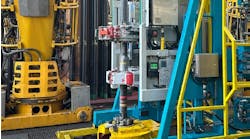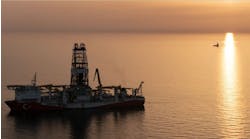Bruce Beaubouef
Managing Editor
Operators workingoffshore Australia continue to move forward with plans to develop and produce oil and gas from fields in deepwater and remote areas.
While a number of recent projects offshore Australia have been located in relatively shallow waters, theGreater Enfield development project marks a notable milestone in the country’s deepwater development.
It involves the development of the Laverda Canyon, Norton over Laverda, and Cimatti oilfields offshore Australia. The fields are located within the offshore Carnarvon basin, approximately 60 km (37 mi) northwest of Exmouth, Western Australia. The Laverda accumulations are situated at a water depth of 550 m (1,804 ft), whereas the Cimatti accumulation is situated at a water depth of 850 m (2,788 ft).
The project is owned by the joint venture of Woodside Energy (60%) and Mitsui E&P Australia (40%). Woodside Energy is the operator for the project. The final investment decision for the project was made in June 2016 and first production is anticipated in mid-2019. The overall investment in the project is estimated to be $1.9 billion.
The Laverda field was discovered in 2000, whereas the Cimatti field was discovered in 2010. The Laverda field was first appraised in 2011 by drilling the Laverda North-1 well at a water depth of 809 m (2,654 ft) and to total depth of 2,282 m (7,486 ft). It was further successfully appraised by drilling the Laverda North-2 well to a total depth of 2,300 m (7,545 ft), which discovered a gross interval of 18 m (59 ft) of oil-bearing sands.
Another appraisal well, the Norton-1, was drilled in February 2012 at a water depth of 782 m (2,565 ft) and to a total depth of 1,718 m (5,636 ft). It encountered oil and gas and confirmed the easterly extension of the oil-bearing sands discovered by the Laverda North-2 appraisal well.
The Cimatti field was discovered in November 2010 by drilling the Cimatti-1 well at a water depth of 547 m (1,794 ft), and to a total depth of 2,424 m (7,952 ft). It intersected a gross oil column of 15 m (49 ft).
The field was appraised in the same month through the drilling of the Cimatti-2 well at a water depth of 547 m (1,794 ft), and to a total depth of 2,460 m (8,070 ft). The well intersected a 7-m (23-ft) thick oil-bearing sand.
The project is estimated to hold proven and probable (2P) reserves of 69 MMboe. The development is planned to have six subsea production wells and six water injection wells. Production will be supported by subsea multiphase booster pumps in the Laverda area and gas lift in the Cimatti area.
These fields will be produced via a 31-km (19-mi) subsea tieback to the Ngujima-Yin FPSO which serves the Vincent oil field. Commissioned in 2008, the FPSO has an oil processing capacity of 120,000 b/d.
The FPSO’s topsides, hull, and turret will also be modified to accommodate the capacity from the new fields. The vessel is connected to the seabed, at a water depth of approximately 340 m (1,115 ft), using a disconnectable turret mooring system.
The front-end engineering and design (FEED) study for the project’s subsea production system and the subsea multiphase booster pumps was performed last year by OneSubsea, while the FEED study for the subsea tieback system was performed by Aibel Pte Ltd.
The Norton-1 well was drilled by Diamond Offshore’sOcean America semisubmersible drilling rig, with support provided by Farstad Shipping’s Lady Caroline and Far Strait anchor handling and supply vessels.
In July, Woodside awarded OneSubsea a $300-million engineering, procurement, and construction contract to supply a subsea production system and a dual multiphase boosting system for the project. The scope of contract includes six horizontal SpoolTree subsea trees, six horizontal trees for the water injection system, six multiphase meters, a high-boost dual pump station with high-voltage motors, umbilical, topsides, subsea controls and distribution, intervention and workover control systems, landing string, and installation and commissioning services.
OneSubsea has contracted Nexans for the project’s umbilical and accessories. The $24-million package will be Nexans’ first delivery to a project offshore Australia. The umbilical will be installed in water depths of up to 915 m (3,002 ft), and will comprise both dynamic and static sections. A January 2018 delivery is anticipated.
Woodside awarded Aibel a contract for modifications on theNguijma-Yin FPSO. This work will involve modifications to the topsides, hull, and turret, along with installation of a new custom water-flood module. Work was expected to begin in July and advance toward a January 2019 completion date.




